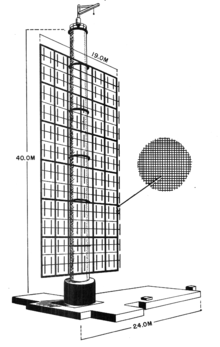Wassermann radar
 Wassermann-radar at Bergen-aan-Zee | |
| Country of origin | Germany |
|---|---|
| Introduced | 1942? |
| Type | Long-range height finding radar |
| Frequency | 120-150 MHz |
| Pulsewidth | 2-3 μs |
| Range | 300 kilometres (190 mi) |
| Azimuth | 360° |
| Precision | ±1,000 feet (300 m) |
| Power | 100 kW |
.jpg)
The Wasserman radar was a long-range, height finder radar built by Germany during World War II. The radar was a development of FuMG 80 Freya and was operated during World War II for long range detection. This device for ground based operation was developed under the direction of Theodor Schultes, starting in 1942. Wasserman was based on largely unchanged Freya electronics, but used an entirely new antenna array in order to improve range and bearing precision.
Development

Seven different versions were developed. The two most important versions are:
- The radio measurement equipment FuMG.41 Wassermann L(German: Leicht = light) was a constellation of four Freya-antenna ranges on top of each other, mounted on a 40 meter high rotatable steel grid mast.
- A later version was the FuMG.42 Wassermann S(German: Schwer = heavy). For this eight Freya antenna arrays were mounted on a 60 meter high pipe mast, two columns of each four antennae high.
The combination of the antennae in this way resulted in a concentration of the radiated energy to a smaller beam, thus resulting in a higher radiated power in the main direction (Effective Radiated Power = ERP), without increasing the transmitter power. The result was a longer range. With the L-version the horizontal opening angle of the antenna array remained the same, but the vertical opening angle was reduced (so flatter radiation pattern). Because the horizontal opening angle was not changed, the bearing measuring performance was not changed. With the S-version also the horizontal opening angle was reduced, with a better bearing resolution as a result.
Technical Info[1]

- Search bearing: mechanical rotation of 360°
- Range: depending of target altitude and station altitude, z. B.
- Target altitude Range
- 50 m 35 km
- 6.000 m 190 km
- Range accuracy: +/− 300 m
- Detection accuracy:
- • Bearing: +/− ¼°
- • Altitude: +/− ¾° (in the range of 3–18°)
- • Altitude detection possible
- Detection possibly up to 12.000 m
- Mass: 30–60 t
- Seize: Height of mast: 37–57 m
- Width 6–12,40 m
- Jamming resisted due to three different frequency ranges:
- • 1,9–2,5 m
- • 1,2–1,9 m
- • 2,4–4,0 m
- Detection of Friend or Foe in cooperation with the FuG.25a Erstling equipment.
References
- ↑ Gebhard Aders: Geschichte der deutschen Nachtjagd 1917 – 1945. 1. Aufl., 1977, S. 357
- Swords, Sean S. (1986). Technical History of the Beginnings of Radar. London: IEE/Peter Peregrinus. ISBN 0-86341-043-X.
